There were many methods of torture which were practiced during the Medieval era of the Middle Ages:
Ripping out teeth / nails
Beating
Blinding
Boiling
Bone breaking
Branding and Burning
Castration
Choking
Cutting
Disfigurement
Dislocation
Drowning
Flagellation, whipping and beating
Flaying
Roasting
Genital mutilation
Limb/finger removal
Starvation
Tongue removal
There was even a torture which used tickling as a method to inflict suffering. Other tortures included the compression of the limbs by special instruments, or by ropes, injection of water, vinegar, or oil, into the body of the accused, application of hot pitch, and starvation, were the processes used in tortures.
Instruments or devices of Middle Ages Torture
The instruments or devices used in Medieval torture of the Middle Ages included some of the following terrible tools or machines:
Boot or Spanish boot
Branding Irons
Brank
The Collar
Drunkards Cloak
Ducking stools
Foot press
Foot screw
The Gossip's Bridle or the Brank
Heretic's fork
The Maiden
Pillory
Rack
Scavenger's daughter
Scold's bridle
Stocks
Thumbscrew
The Wheel
Middle Ages Torture and Execution
A skilled torturer would use methods, devices and instruments to prolong life as long as possible whilst inflicting agonising pain. However, the customs of the Medieval period dictated that many prisoners were tortured before they were executed in order to obtain additional information about their crime or their accomplices. There were many forms of torture and execution. The execution method itself was part of the torture endured by prisoners. These final methods of torture and execution included the following methods:
Torture and execution by Fire
The Sword or the Axe
Mechanical force
Quartering
The Wheel
The Fork
The Gibbet
Spiking
Dismembering
Middle Ages Torture Chambers and Dungeons
The torture chambers were located in the lower parts of castles. The entrances to many torture chambers were accessed through winding passages which served to muffle the agonising cries of torture victims from the normal inhabitants of the castle. internal government of prisons. Torture chambers and dungeons were often very small some measured only eleven feet long by seven feet wide in which from ten to twenty prisoners were often incarcerated at the same time.
Middle Ages Torture was condemned in 866
The barbarous custom of punishment by torture was on several occasions condemned by the Church. As early as 866, we find, from Pope Nicholas V's letter to the Bulgarians, that their custom of torturing the accused was considered contrary to divine as well as to human law: "For," says he, "a confession should be voluntary, and not forced. By means of the torture, an innocent man may suffer to the utmost without making any avowal; and, in such a case, what a crime for the judge! Or the person may be subdued by pain, and may acknowledge himself guilty, although he be not so, which throws an equally great sin upon the judge." Despite this, and other please, the practise of torturing victims continued. Medieval Torture was a freely accepted form of punishment in the Middle Ages and was only abolished in England in 1640.










| |
| |
| |
| |






The head crusher simply crushed your head.

The whirligig was not that bad of a torture. It just span the victim til they puked.

The cat's paw was a short pole with a pitch fork at one end. It was used to tear the the flesh of the victim.

The heretic fork was a two sided prong that went between your chin and your chest. You could not talk with instrument in place and it was very painful.

The chair of spikes was a chair of spikes. The victim would sit in the chair and weights would be applied onto the victim forcing his body into the metal spikes.
The cross was of several kinds; one in the shape of an X, called crux Andreana, because tradition reports St. Andrew to have suffered upon it; another was formed like a T, as we learn from Lucian (Judic. Vocal. xii), who makes it the subject of a charge against the letter.
The third, and most common sort, was made of two pieces of wood crossed, so as to make four right angles. It was on this, according to the unanimous testimony of the fathers who sought to confirm it by Scripture itself (Lips. De Cruce, i.9), that our Saviour suffered. The punishment, as is well known, was chiefly inflicted on slaves, and the worst kind of malefactors . The manner of it was as follows:
The criminal, after sentence pronounced, carried his cross to the place of execution; a custom mentioned by Plutarch (De Tard. Dei Vind. ἕκαστος τῶν κακούργων ἐκφέρει τὸν αὐτοῦ σταυρόν), and Artemidorus (Oneir. ii.61), as well as in the Gospels. From Livy and Valerius Maximus , scourging appears to have formed a part of this, as of other capital punishments among the Romans. The scourging of our Saviour, however, is not to be regarded in this light, for, as Grotius and Hammond have observed, it was inflicted before sentence was pronounced the criminal was next stripped of his clothes and nailed or bound to the cross. The latter was the more painful method, as the sufferer was left to die of hunger. Instances are recorded of persons who survived nine days. It was usual to leave the body on the cross after death. The breaking of the legs of the thieves, mentioned in the Gospels, p371was accidental, because by the Jewish law, it is expressly remarked, the bodies could not remain on the cross during the Sabbath-day. (Lipsius, De Cruce; Casaubon, Exer. Antibaron. xvi.77.)
Crucifixion is the act of nailing, binding or impaling a living victim or sometimes a dead person to a cross, stake or a tree, whether for executing the body or for exposing the corpse. Crucifixion was intended to serve as both a severe punishment and a frightful deterrent to others. It was unanimously considered the most horrible form of death.
The cross (Greek stauros; Latin crux) was originally a single upright stake or post upon which the victim was either tied, nailed or impaled. This simple cross was later modified when horizontal crossbeams of various types were added. Scholars are not certain when a crossbeam was added to the simple stake, but even in the Roman period the cross would at times only consist of a single vertical stake. In many cases, especially during the Roman period, the execution stake became a vertical pole with a horizontal crossbar placed at some point, and although the period of time at which this happened is uncertain, what is known is that this simple impalement became known as crucifixion. Whether the victim was tied, nailed or impaled to the stake, the same Greek words were still used to describe the procedure.
A primitive form of crucifixion on trees had long been in use, and such a tree was also known as a cross (crux). Different ideas also prevailed concerning the material form of the cross, and it seems that the word had been frequently used in a broad sense. The Latin word crux was applied to the simple pole, and indicated directly the nature and purpose of this instrument, being derived from the verb crucio, "to torment", "to torture." The practice of crucifixion was finally abolished in 337 by Constantine I out of respect for Jesus Christ, whom he believed died on the cross.
Perhaps one of the best examples of the variation of crucifixion in the form of impaling the enemies comes from the times of the Assyrian ruler Shalmaneser III (859 BCE - 824 BCE). Figures 1 and 2 show people being impaled by a stake through their private parts and chests, respectively.
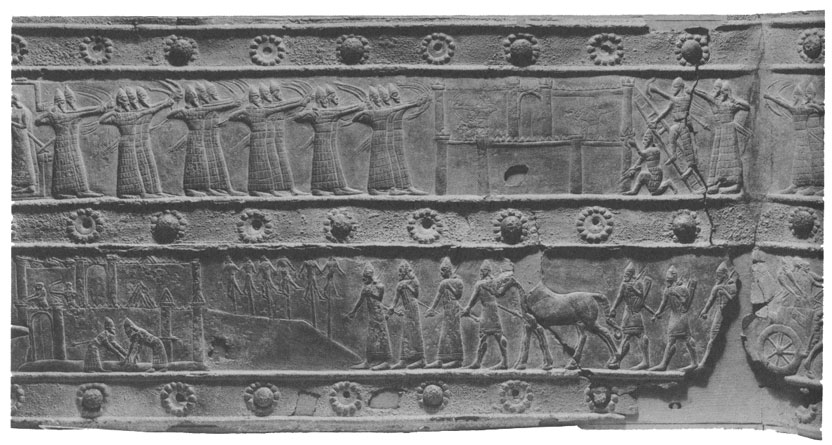
Figure 1: Shalmaneser III's campaign in north Syria: town of Dabigu (top), impaled inhabitants of Syrian town (below). Also notice that the inhabitants have been impaled by a stake through their private parts.
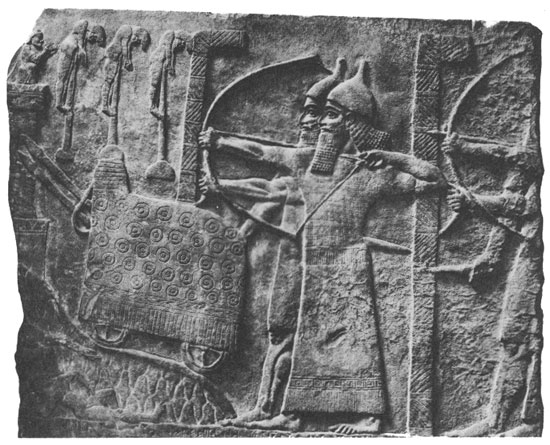
Figure 2: Attack of the walls of a town by a seige-engine supported by bowmen protected by shields. The bodies of the three townsmen are impaled outside the wall. Here the stake went through the chest.
The famous account for the evidence of the Assyrian crucifixion, often repeated in the scholarly literature, is that of Assyrian king Ninus who had the Median king Pharnus crucified.
ὁ δὲ ταυτ́ης βασιλεὺς Φαρνος παραταξάμενος ἀξιολόγω δυνάμει καὶ λειφθείς, τω̂ν τε στρατιωτω̂ν τοὺς πλείους ἀπέβαλε καὶ αὐτὸς μετὰ τέκνων ἑπτὰ καὶ γυναικὸς αἰχμάλωτος ληφθεὶς ἀνεσταυρώθη.
ho de tautis basileus Parnos parataxamenos axiologo dunamei kai leiphtheis, tôn te stratiotôn tous pleious apebale kai autos peta teknon epta kai gunaikos aichmalotos lêphtheis anestaurôthi.
And the king of this country, Pharnus, meeting him in battle with a formidable force, was defeated, and he both lost the larger part of his soldiers, and himself, being taken captive, along with his seven sons and wife, and crucified.
The English translation uses the word "crucified" which is the translation of the Greek word anestaurôthi from the verb anastauroô meaning "to impale". This word is now usually translated to mean "impale" in the literature. It should be noted, however, that it is believed that the report of Diodorus has no historical value. Nevertheless, it is interesting to note that the example of crucifixion given in early Assyrian times was nothing but impalement. In spite of the evidence of crucifixion or impalement in the Code of Hammurabi and in Assyria, many authors wrongly refer to Herodotus' (5th century BCE) writings as the source to claim that the earliest references of crucifixion comes from Persia.
HERODOTUS' ACCOUNTS OF CRUCIFIXION
Herodotus was born in Halicarnassus, Anatolia not long after 480 BCE and died some time between 430-420 BCE. Herodotus refers to the stake as a method of execution, but also gives an example of a victim being nailed on a board. We will discuss a few instances where he mentions impalement in his Histories.
διαλυθέντος δὲ του̂ Μηδικου̂. στρατεύματος αἰσχρω̂ς, ὡς ἐπύθετο τάχιστα ὁ ̓Αστυάγης, ἔφη ἀπειλέων τῳ̂ Κύρῳ "ἀλλ' οὐδ' ὣς Κυ̂ρός γε χαιρήσει." τοσαυ̂τα εἰ̂πας πρω̂τον μὲν τω̂ν Μάγων τοὺς ὀνειροπόλους, οἵ μιν ἀνέγνωσαν μετει̂ναι τὸν Κυ̂ρον, τούτους ἀνεσκολόπισε, μετὰ δὲ ὥπλισε τοὺς ὑπολειφθέντας ἐν τῳ̂ ἄστεϊ τω̂ν Μήδων, νέους τε καὶ πρεσβύτας ἄνδρας. ἐξαγαγὼν δὲ τούτους καὶ συμβαλὼν τοι̂σι Πέρῃσι ἑσσώθη, καὶ αὐτός τε ̓Αστυάγης ἐζωγρήθη καὶ τοὺς ἐξήγαγε τω̂ν Μήδων ἀπέβαλε.
dialuthentos de tou Mêdikou. strateumatos aischrôs, hôs eputheto tachista ho Astuagês, ephê apeileôn tôi Kurôi "all' oud' hôs Kuros ge chairêsei." tosauta eipas prôton men tôn Magôn tous oneiropolous, hoi min anegnôsan meteinai ton Kuron, toutous anasklopise, meta de hôplise tous hupoleiphthentas en tôi asteï tôn Mêdôn, neous te kai presbutas andras. exagagôn de toutous kai sumbalôn toisi Perêisi hessôthê, kai autos te Astuagês ezôgrêthê kai tous exêgage tôn Mêdôn apebale.
Thus the Median army was foully scattered. Astyages, hearing this, sent a threatening message to Cyrus: "that even so he should not go unpunished"; and with that he took the Magians who interpreted dreams and had persuaded him to let Cyrus go free, and impaled them; then he armed the Medes who were left in the city, the youths and the old men. Leading these out, and encountering the Persians, he was worsted: Astyages himself was taken prisoner, and lost the Median army which he led.
ἀποκτείνας δέ μιν οὐκ ἀξίως ἀπηγήσιος ̓Οροίτης ἀνεσταύρωσε: τω̂ν δέ οἱ ἑπομένων ὅσοι μὲν ἠ̂σαν Σάμιοι, ἀπη̂κε, κελεύων σφέας ἑωυτῳ̂ χάριν εἰδέναι ἐόντας ἐλευθέρους, ὅσοι δὲ ἠ̂σαν ξει̂νοί τε καὶ δου̂λοι τω̂ν ἑπομένων, ἐν ἀνδραπόδων λόγῳ ποιεύμενος εἰ̂χε. Πολυκράτης δὲ ἀνακρεμάμενος ἐπετέλεε πα̂σαν τὴν ὄψιν τη̂ς θυγατρός: ἐλου̂το μὲν γὰρ ὑπὸ του̂ Διὸς ὅκως ὕοι, ἐχρίετο δὲ ὑπὸ του̂ ἡλίου, ἀνιεὶς αὐτὸς ἐκ του̂ σώματος ἰκμάδα.
apokteinas de min ouk axiôs apêgêsios Oroitês anestaurôse: tôn de hoi hepomenôn hosoi men êsan Samioi, apêke, keleuôn spheas heôutôi charin eidenai eontas eleutherous, hosoi de êsan xeinoi te kai douloi tôn hepomenôn, en andrapodôn logôi poieumenos eiche. Polukratês de anakremamenos epetelee pasan tên opsin tês thugatros: elouto men gar hupo tou Dios hokôs huoi, echrieto de hupo tou hêliou, anieis autos ek tou sômatos ikmada.
Having killed him (in some way not fit to be told), Oroetes then crucified him; as for the Samians in his retinue he let them go, bidding them thank Oroetus for their freedom; and those who were not Samians, or were servants of Polycrates' followers, he kept for slaves. So Polycrates was hanged aloft, and thereby his daughter's dream came true; for he was wahed by Zeus when it rained, and the moisture from his body was his anointment by the sun.
τότε δὴ ὁ Δημοκήδης ἐν τοι̂σι Σούσοισι ἐξιησάμενος Δαρει̂ον οἰ̂κόν τε μέγιστον εἰ̂χε καὶ ὁμοτράπεζος βασιλέι ἐγεγόνεε, πλήν τε ἑνὸς του̂ ἐς ̔́Ελληνας ἀπιέναι πάντα τἀ̂λλά οἱ παρη̂ν. καὶ του̂το μὲν τοὺς Αἰγυπτίους ἰητρούς, οἳ βασιλέα πρότερον ἰω̂ντο, μέλλοντας ἀνασκολοπιει̂σθαι ὅτι ὑπὸ ̔́Ελληνος ἰητρου̂ ἑσσώθησαν, τούτους βασιλέα παραιτησάμενος ἐρρύσατο: του̂το δὲ μάντιν ̓Ηλει̂ον Πολυκράτεϊ ἐπισπόμενον καὶ ἀπημελημένον ἐν τοι̂σι ἀνδραπόδοισι ἐρρύσατο. ἠ̂ν δὲ μέγιστον πρη̂γμα Δημοκήδης παρὰ βασιλέι.
tote dê ho Dêmokêdês en toisi Sousoisi exiêsamenos Dareion oikon te megiston eiche kai homotrapezos basilei egegonee, plên te henos tou es Hellênas apienai panta talla hoi parên. kai touto men tous Aiguptious iêtrous, hoi basilea proteron iônto, mellontas anaskolopieisthai hoti hupo Hellênos iêtrou hessôthêsan, toutous basilea paraitêsamenos errusato: touto de mantin Êleion Polukrateï epispomenon kai apêmelêmenon en toisi andrapodoisi errusato. ên de megiston prêgma Dêmokêdês para basilei.
So now having healed Darius at Susa Democedes had a very grand house and ate at the king's table; all was his, except permission to return to his Greek home. [3.132.2] When the Egyptian chirurgeons who had till now attended on the king were about to be impaled for being less skilful than a Greek, Democedes begged their lives of the king and saved them; and he saved besides an Elean diviner, too, who had been of Polycrates' retinue and was left neglected among the slaves. Mightily in favour with the king was Democedes.
Βαβυλὼν μέν νυν οὕτω τὸ δεύτερον αἱρέθη. Δαρει̂ος δὲ ἐπείτε ἐκράτησε τω̂ν Βαβυλωνίων, του̂το μὲν σφέων τὸ τει̂χος περιει̂λε καὶ τὰς πύλας πάσας ἀπέσπασε: τὸ γὰρ πρότερον ἑλὼν Κυ̂ρος τὴν Βαβυλω̂να ἐποίησε τούτων οὐδέτερον: του̂το δὲ ὁ Δαρει̂ος τω̂ν ἀνδρω̂ν τοὺς κορυφαίους μάλιστα ἐς τρισχιλίους ἀνεσκολόπισε, τοι̂σι δὲ λοιποι̂σι Βαβυλωνίοισι ἀπέδωκε τὴν πόλιν οἰκέειν.
Babulôn men nun houtô to deuteron hairethê. Dareios de epeite ekratêse tôn Babulôniôn, touto men spheôn to teichos perieile kai tas pulas pasas apespase: to gar proteron helôn Kuros tên Babulôna epoiêse toutôn oudeteron: touto de ho Dareios tôn andrôn tous koruphaious malista es trischiliousaneskolopise, toisi de loipoisi Babulônioisi apedôke tên polin oikeein.
Thus was Babylon the second time taken. Having mastered the Babylonians, Darius destroyed their walls and left away all their gates, neither of which things Cyrus had done at the first taking of Babylon; moreover he impaled about three thousand men that were prominent among them; as for the rest, he gave them back their city to dwell in.
This is Herodotus' famous account of how Darius I, king of Persia, crucified 3,000 political prisoners.
ταυ̂τα ὑπισχόμενος τὸν στρατηγὸν Ξάνθιππον οὐκ ἔπειθε: οἱ γὰρ ̓Ελαιούσιοι τῳ̂ Πρωτεσίλεῳ τιμωρέοντες ἐδέοντό μιν καταχρησθη̂ναι, καὶ αὐτου̂ του̂ στρατηγου̂ ταύτῃ νόος ἔφερε. ἀπαγαγόντες δὲ αὐτὸν ἐς τὴν Ξέρξης ἔζευξε τὸν πόρον, οἳ δὲ λέγουσι ἐπὶ τὸν κολωνὸν τὸν ὑπὲρ Μαδύτου πόλιος, πρὸς σανίδας προσπασσαλεύσαντες ἀνεκρέμασαν: τὸν δὲ παι̂δα ἐν ὀφθαλμοι̂σι του̂ ̓Αρταύ̈κτεω κατέλευσαν.
tauta hupischomenos ton stratêgon Xanthippon ouk epeithe: hoi gar Elaiousioi tôi Prôtesileôi timôreontes edeonto min katachrêsthênai, kai autou tou stratêgou tautêi noos ephere. apagagontes de auton es tên Xerxês ezeuxe ton poron, hoi de legousi epi ton kolônon ton huper Madutou polios,pros sanidas prospassaleusantes anekremasan: ton de paida en ophthalmoisi tou Artaükteô kateleusan.
But Xanthippus the general was unmoved by this promise; for the people of Elaeus entreated that Artayctes should be put to death in justice to Protesilaus, and the general himself was so minded. So they carried Artayctes away to the headland where Xerxes had bridged the strait (or, by another story, to the hill above the town of Madytus), and there nailed him to boards and hanged him; and as for his son, they stoned him to death before his father's eyes.
Note that neither of the two verbs anastauroô or anaskolopizô appear in the only detailed account of crucifixion given by Herodotus in which the victim was "hanged" by being nailed to boards or planks.
There appears to be no word for "crucifixion" as such in Greek. The Greek text of Herodotus speaks of "impalement" which is sometimes translated as crucifixion. Herodotus uses the verbs anaskolopizô and anastauroô both of which mean "to impale". Generally Herodotus uses the derivatives of the verb anaskolopizô for living persons and anastauroô for corpses. After him the verbs become synonymous, 'to crucify', in modern literature.
In many cases, especially during the Roman period, the execution stake became a vertical pole with a horizontal crossbar placed at some point, and although the period of time at which this happened is uncertain, what is known is that this simple impalement later became to be known as crucifixion. Whether the victim was tied, nailed or impaled to the stake, the same Greek words were still used to described the procedure.
EVIDENCE OF IMPALEMENT IN ANCIENT EGYPT
The first thing to establish is whether there exists any hieroglyph that mentions impaling people on stakes. The best place to start is Die Sprache Der Pharaonen Großes Handwörterbuch Ägyptisch, a concise Egyptian-German dictionary. The hieroglyph depicting impalement on a stake is shown below.

Figure 4: Hieroglyph writing for "Stake. rdj hr = To put on the stake (for punishment)"; det. = determinative, hieroglyph for classifying Egyptian words. Here it shows an impaled man bent upon a stake.
A recent edition of Die Sprache Der Pharaonen Großes Handwörterbuch Ägyptisch gives even more information on the hieroglyphs showing impalement as seen below.
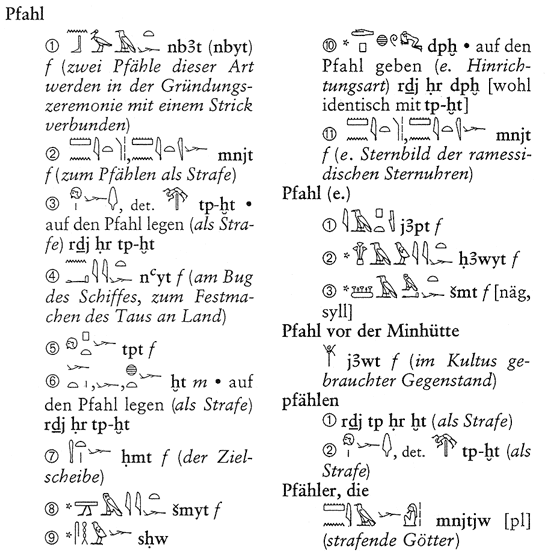
Figure 5: Hieroglyph writing for Pfahl, i.e., "Stake". The interesting ones of 2, 3, 5, and 6. Also see "Pfählen".
This is the clearest example that people in Egypt were crucified by impaling them on stakes. What about the times in which this punishment was imposed in Egypt?
In order to understand the evidence of crucifixion by impaling people on a stake in Egypt, a simplified chronology of ancient Egyptian history containing royal names associated with the period were shown for easy reference. Please note that the exact Egyptian chronologies are slightly uncertain, and all dates are approximate.
| Dynasties | Dates BCE (approx.) | Period | Some Royal Names Associated with Period |
| 1 & 2 | c. 3150 - 2700 | Thinite Period | Narmer-Menes, Aha, Djer, Hetepsekhemwy, Peribsen |
| 3 - 6 | c. 2700 - 2190 | Old Kingdom | Djoser, Snofru, Khufu (Cheops), Khafre (Chephren), Menkauhor, Teti, Pepy. |
| 7 - 11 | c. 2200 - 2040 | First Intermediate | Neferkare, Mentuhotpe, Inyotef |
| 11 & 12 | c. 2040 - 1674 | Middle Kingdom | Ammenemes, Sesostris, Dedumesiu |
| 13 - 17 | c. 1674 - 1553 | Second Intermediate | Sobekhotep II, Chendjer, Salitis, Yaqub-Har, Kamose, Seqenenre, Apophis. Hyksos formed 15th and 16th Dynasties |
| 18 - 20 | c. 1552 - 1069 | New Kingdom | Ahmose, Amenhotep (Amenophis), Hatshepsut, Akhenaten (Amenophis IV), Horemheb, Seti (Sethos), Ramesses, Merenptah |
Table I: Chronology of Egyptians Dynasties
The evidence is arranged in chronological order.
A. Theban Account Papyrus (Papyrus Boulaq 18)
Papyrus Boulaq 18 is dated to the early Second Intermediate Period reign of Chendjer / Sobekhotep II; both of them kings from the 13th Dynasty. The account in Papyrus Boulaq is given below.
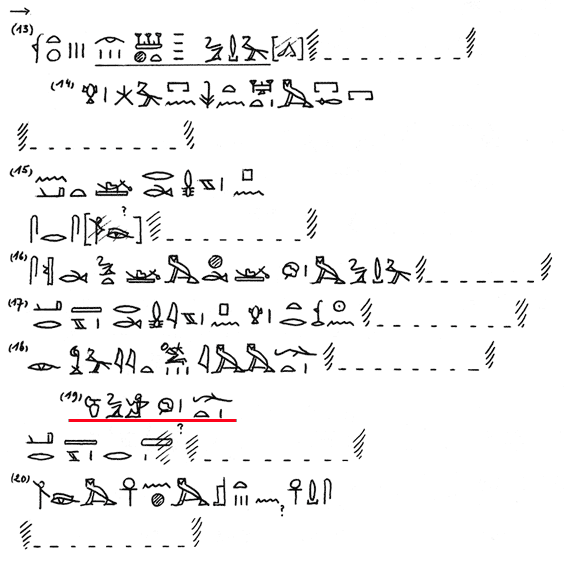
Figure 6: Mentioning of impalement in the Theban account papyrus (Papyrus Boulaq 18).
a blood bath (?) had occurred with (by?) wood (?) ... the comrade was put on the stake, land near the island ...; waking alive at the places of life, safety and health ...
B. Stela Of Amenophis IV (Akhenaten)
Amenophis IV or Akhenaten was known as the Heretic King. He was the tenth king of the 18th Dynasty in the New Kingdom Period. This is an interesting stela showing the Nubian prisoners of war being impaled.
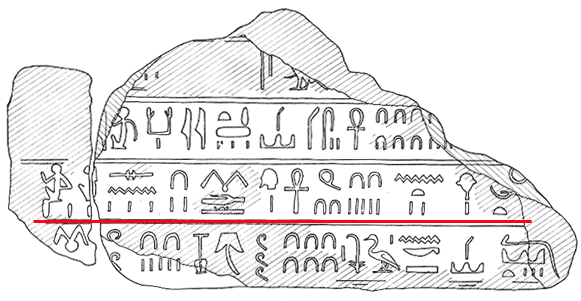
Figure 7: Excerpts from the Stela of Amenophis IV, showing impalement of Nubian prisoners of war.
List (of the enemy belonging to) Ikayta: living Nehesi 80+ ?; ... | ... their (chiefs?) 12; total number of live captives 145; those who were impaled ... | ... total 225; beasts 361.
C. Abydos Decree Of Sethos I At Nauri, Year 4.
Sethos I belonged to the 19th Dynasty in the New Kingdom Period. His rule preceded the rule of Ramesses II. Below is his interesting decree at Nauri.

Figure 8: Excerpts from the Abydos Decree of Sethos I at Nauri, Year 4.
... Now as for any superintendent of cattle, any superintendent of donkeys, any herdsman belonging to the Temple of Menmare Happy in Abydos, who shall sell of any beast belonging to the Temple of Menmare Happy in Abydos to someone else; likewise whoever may cause it to be offered on some other document, and it not be offered to Osiris his master in the Temple of Menmare Happy in Abydos; the law shall be executed against him, by condemning him, impaled on the stake, along with forfeiting(?) his wife, his children and all his property to the Temple of Menmare Happy in Abydos, ...
D. Amada Stela Of Merenptah: Libyan War (Karnak)
Merenptah, son of Ramesses II, defeated the threat posed by the Libyans. He belonged to the 19th Dynasty in the New Kingdom Period. Here the prisoners were impaled on the stake on the South of Memphis.

Figure 9: Excerpts from the Amada Stela of Merenptah; Libyan War (Karnak).
... Never shall they leave any people for the Libu (i.e., Libyans), any who shall bring them up in their land! They are cast to the ground, (?) by hundred-thousands and ten thousands, the remainder being impaled ('put to the stake') on the South of Memphis. All their property was plundered, being brough back to Egypt...
E. The Abbott Papyrus
This is an account of the Great Tomb Robberies of the 20th Dynasty in the New Kingdom Period. Notice that the oath includes mutilation before the actual impalement.

Figure 10: Excerpts from the Abbott Papyrus that deals with the oath on pain of mutilation and impalement.
... The notables caused this coppersmith to be examined in most severe examination in the Great Valley, but it could not be found that he knew of any place there save the two places he had pointed out. He took an oath on pain of being beaten, of having his nose and ears cut off, and of being impaled, saying I know of no place here among these tombs except this tomb which is open and this house which I pointed to you...
F. Papyrus BM10052
This is an account of the Great Tomb Robberies of the 20th Dynasty in the New Kingdom Period. Notice that the oath includes mutilation before the actual impalement.

Figure 11: Excerpts from Papyrus BM10052.
The scribe Paoemtaumt was brought. he was given the oath not to speak falsehood. He said, As Amun lives and as the Ruler lives, if I be found to have had anything to do with any one of the thieves may I be mutilated in nose and ears and placed on the stake. He was examined with the stick. He was found to have been arrested on account of the measurer Paoemtaumt son of Kaka.
These hieroglyphs are by no means the only ones. There exist others from the New Kingdom Period showing impalements.
CAPITAL PUNISHMENT IN ANCIENT EGYPT
Ancient Egypt was known for some of the worst kinds of capital punishments. The ancient Egyptians understood the necessary deterrent that these punishments provided. It appears that punishment in ancient Egypt became more severe with the times, especially with the advent of the New Kingdom Period. The punishments in the New Kingdom Period were very brutal and included beatings, mutilation, impalement, and being treated as a slave. The Lexikon Der Ägyptologie - an encyclopaedia of Egyptology, gives a brief overview of the different forms of punishment in Egypt under the heading "Strafen" (i.e., punishment / penalties). It says:
Decrees and trial documents, in the latter particularly from oath formulas, have given us the following judicial punishments. Physical punishments, as the most severe for capital crimes ... the death penalty by impaling, burning, drowning, beheading or being eating by wild animals. Only the King or the Vizier had the right to impose such punishment. High ranking personalities were granted by the King to commit suicide.
Physical punishments were also mutilation punishments by cutting off hands, tongue, nose and or ears, castration as well as beatings in the form of 100 or 200 strokes, often with 5 bleeding wounds, occasionally with 10 burn marks. Sometimes also the part of the body, e.g. the soles of the feet, which had to be beaten.
Frequently there were prison sentences in addition to physical punishments, such as exile to Kusch, to the Great Oasis or to Sile, with the obligation of forced labour as mine worker or stone mason as well as loss of assets. Women were banished to live in the outbuildings at the back of the house. Prison sentences as we know them were unknown. There were just remand prison for the accused and witnesses for serious crimes before and during the trial. Abuse of office was punished by loss of office and transfer to manual work.[53]
Similarly Lurje in his Studien Zum Altägyptischen Recht (Studies In The Ancient Egyptian Law) states:
Among others we find mutilation, mutilation and deportation to forced labour in Ethiopia, just deportation to forced labour in Ethiopia, impaling (tp-ht), punishment in form of 100 beatings and adding 50 wounds, punishment in form of 100 beatings and withdrawal of part or all of the disputed assets, punishment in form of 100 beatings and payment of twice the value of the matter in dispute, asset liability, cutting off of the tongue, loss of rank and transfer to the working class, handing over to be eaten by the crocodile and finally living in the outbuildings of the house.[54]
It is clear that one of the severest penalties in ancient Egypt included mutilation, mutilation and then impalement especially in the New Kingdom Period. The mutilation includes cutting off hands, tongue, nose and ears or even castration. Harsh penalties such as crucifying by impalement would be imposed only by either the King or the Vizier.
Evidence that have acquired so far about crucifixion in Egypt. Table II shows the ruler of Egypt when people were crucified by impaling on stakes| Dynasties | Dates BCE (approx.) | Period | Ruler When Crucifixion Happened | Prophet |
| 3 - 6 | c. 2700 - 2200 | Old Kingdom | ||
| 7 - 11 | c. 2200 - 2040 | First Intermediate | ||
| 11 & 12 | c. 2040 - 1674 | Middle Kingdom | ||
| 13 - 17 | c. 1674 - 1553 | Second Intermediate | Sobekhotep II, Chendjer (13th Dynasty). | Joseph |
| 18 - 20 | c. 1552 - 1069 | New Kingdom | Akhenaten (Amenophis IV), Ramesses, Merenptah | Moses |
Table II: This Table provides information about the ruler of Egypt when people were crucified by impaling on stakes
What is interesting to note is that the earliest available evidence of the occurrence of crucifixion in Egypt is seen in the Papyrus Boulaq 18 from the time of Sobekhotep II / Chendjer of the 13th Dynasty in the Second Intermediate Period. This means that crucifixion happened in Egypt even before Joseph entered Egypt. Crucifixion also happened before Moses came to Egypt, during the Amenophis IV (Akhenaten). It also happened after the event of Exodus as seen in the papyri related to the Great Tomb Robberies of the 20th Dynasty.
Ancient Peru's torture and sacrifice
A series of grisly executions in the arid valleys of lowland Peru and from the evidence from the skeletal remains shows that the victims, who lived during the Moche civilization nearly two thousand years ago, suffered shockingly brutal deaths. Some were apparently skinned alive. Others were drained of blood, decapitated, or bound tightly and left to be eaten by vultures. When the graves at a Moche temple complex in northern Peru were uncovered, the human remains showed many clear marks of violence. Various theories arose to explain it. One proposes that the Moche sacrificed some of their own people to appease the gods and improve the fertility of their land. Another suggests that the victims were enemies of the Moche executioners—losers of fierce power struggles between competing prehistoric city-states—who were ritually murdered.
The grim events revealed by the archaeological findings have long been familiar to scholars from finely rendered pottery and murals of the Moche people. Scenes embellished with abundant bloodshed show victims being humiliated, abused, and executed.
Some theories have interpreted these frightening scenes as exaggerated fictions concocted by the Moche to scare enemies. The recent analysis, however, suggests that the events depicted were horrifyingly real and not figments of artists' imagination.
The revelation of gruesome forms of torture is puzzling in part because the Moche developed a vibrant and highly advanced culture. These pre-Inca Peruvians were renowned builders, artists, and warriors. Their technological advances included, for example, techniques of irrigation that made their valleys even more productive than the same land is today.The Peruvian culture will be discuss later on the next articles.
Articles submitted to PRSG by
Kim New Jersey












































2 comments:
Was there a torture in Ancient Egypt whereby a woman's vagina was filled with hot liquid resin then left to set. The woman would be left to die of dessication. There might have been means to remove liquids from the body.
Hi there ferret,
Thanks for the info... well havent heard bout it before... would be appreciates if you can share more on the Egyptian tortures :)
Post a Comment